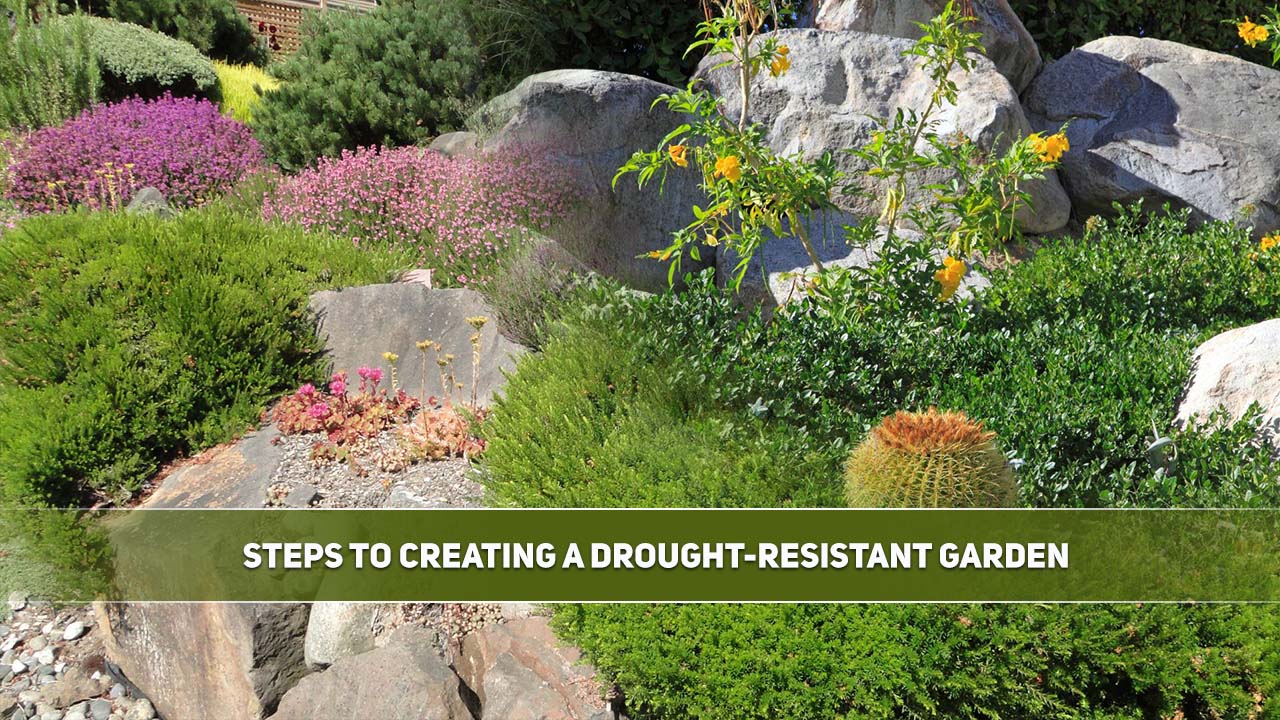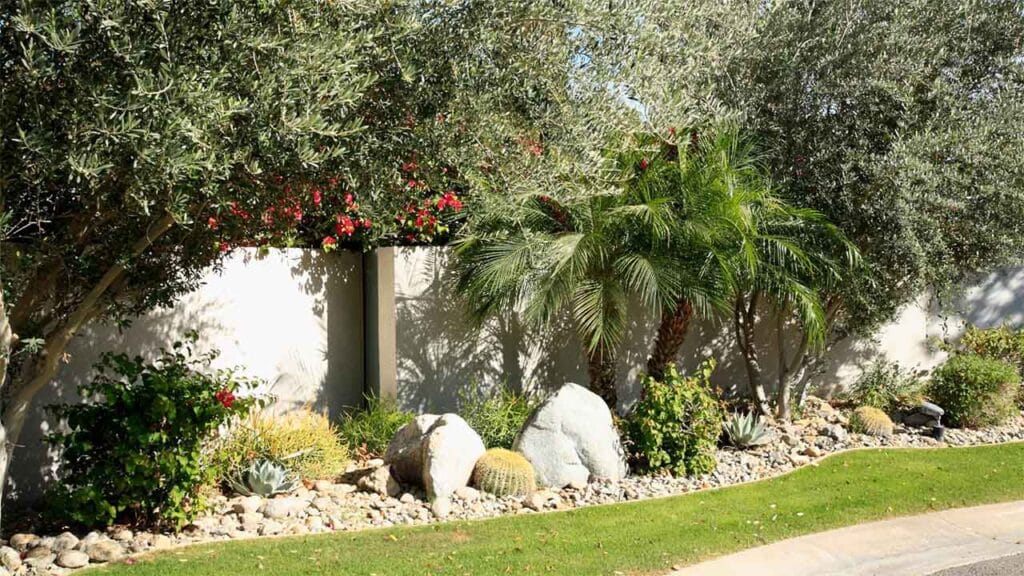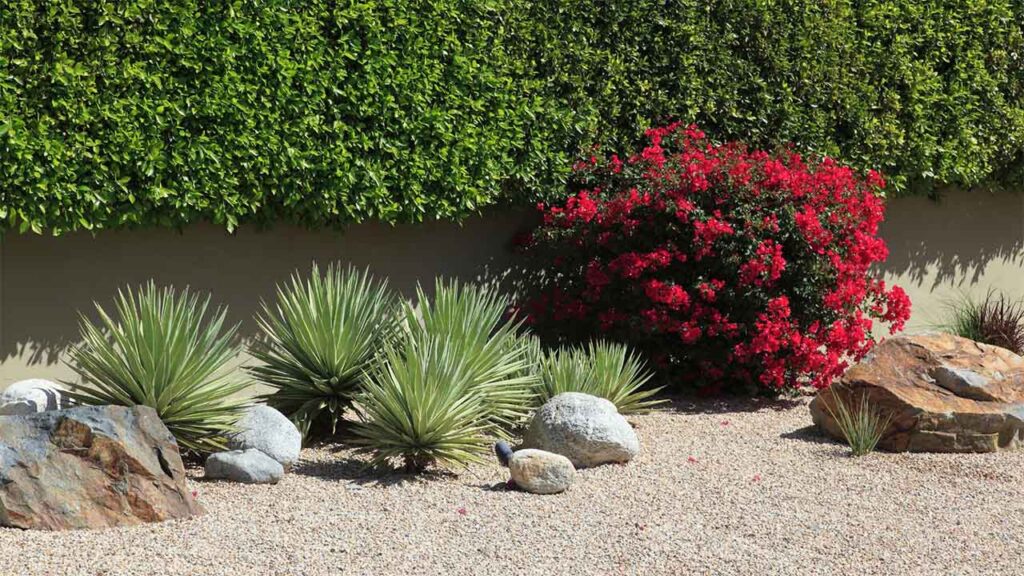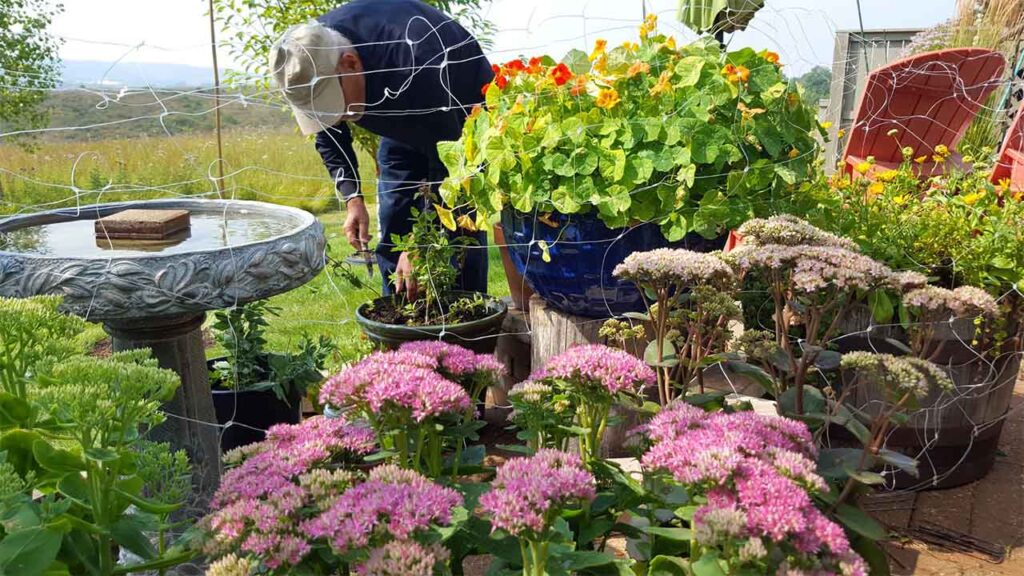Water shortages and droughts are becoming more common. You might be wondering how to keep your garden thriving in dry conditions. A drought-resistant garden can save water and money while still looking beautiful.
Creating a drought-resistant garden is easier than you think. You can have a lush, colorful yard with less water and the right plants and techniques.
This article will show ten simple steps to make your garden drought-tolerant. You’ll learn to choose the best plants, improve your soil, and use intelligent watering methods.
1. Select Native Plants
Native plants are your best friends for a drought-resistant garden. These plants have adapted to your local climate over thousands of years. They can handle the natural rainfall in your area without extra watering.
Choose plants that naturally grow in your region. They’ll thrive with less care and water than non-native species. Native plants also support local wildlife, like birds and butterflies.
Ask at a local nursery for native plant suggestions. They can help you pick plants suited to your specific soil and light conditions. You can also check with your local extension office for native plant lists.
Consider the mature size of plants when selecting. This helps you space them correctly in your garden. Proper spacing allows plants to grow without competing for water and nutrients.
Mix different types of native plants in your garden. Use trees, shrubs, grasses, and flowers. This variety creates a natural look and provides other benefits to wildlife.
Remember, even native plants need regular watering when first planted. Once established, they’ll be drought-tolerant and require less maintenance.
2. Improve Soil Health
Healthy soil is critical for a drought-resistant garden. Good soil holds water better and keeps plants strong. You can make your soil healthier in a few ways.
Add compost to your garden beds. Compost helps soil hold more water. It also gives plants essential nutrients. Mix it into the top layer of soil before planting.
Use mulch around your plants. Mulch can be wood chips, straw, or leaves. It covers the soil and keeps water from evaporating too fast. Mulch also stops weeds from growing.
Avoid walking on your garden soil. This packs it down and makes it hard for water to soak in. Make paths in your garden to walk on instead.
Try not to dig or turn your soil too much. This can hurt helpful soil creatures. Instead, add compost and mulch on top of the soil. Let worms and bugs mix it in naturally.
By improving your soil, you’ll need less water to keep your plants happy. Your garden will be stronger and better able to handle dry times.
3. Implement Drip Irrigation
Drip irrigation is a smart way to water your drought-resistant garden. It saves water and helps your plants thrive.
Start by laying a garden hose around your plants to set up a drip system. Put a cap on the end of the hose.
Next, make small holes in the hose where you want water to come out. You can use a drill or a unique hole punch tool for this.
Connect the hose to your water source. When you turn it on, water will slowly drip from the holes onto your plants’ roots.
Drip irrigation gives water right where plants need it most. This cuts down on waste and keeps your garden healthy with less water.
You can buy drip irrigation kits at garden stores. These often come with all the parts you need to get started.
Remember to check your drip system regularly. Look for clogs or leaks. Fix any problems you find to keep it working well.
4. Mulch Regularly
Mulching is a crucial step in creating a drought-resistant garden. It helps keep moisture in the soil and reduces water loss. You can use various materials such as mulch, wood chips, straw, or gravel.
Apply a 2-3 inch layer of mulch around your plants. Be careful not to pile it against plant stems or tree trunks. This can cause rot and attract pests.
Mulch also helps control weeds. Fewer weeds mean less competition for water. It keeps the soil cooler, too, which is good for plant roots in hot weather.
Remember to replace your mulch as needed. It breaks down over time, especially organic types. You should add more once or twice a year.
Different plants may need different types of mulch. For example, some prefer bark chips, while others do better with pebbles. Research what works best for your garden.
Mulching is an easy way to save water and keep your plants healthy. It’s a simple task that makes a big difference in dry conditions.
5. Install Rain Barrels
Rain barrels are a great way to save water for your drought-resistant garden. You can make your rain barrel using a large plastic garbage can.
First, clean the can inside and out. Then, drill a hole near the bottom for a fixture. You can also add an overflow hole near the top.
Next, cut an opening in the lid for water to enter. Place the barrel under your downspout. You may need to cut the downspout shorter to fit.
Make sure your rain barrel sits on a flat, stable surface. Sand or gravel underneath can help with drainage.
Add an elbow or diverter to your downspout to direct water into the barrel. Position it about 2 inches above the barrel’s inlet.
You’ll collect free water for your garden with your rain barrel set up. This helps conserve resources and saves money on your water bill.
Remember to use the collected water regularly. Empty the barrel between rainstorms to make room for more water.
6. Group Plants by Water Needs
Grouping plants with similar water needs is a smart way to save water in your garden. This method is called hydrozoning. It helps you water more efficiently and keeps your plants healthy.
Start by making a list of the plants you want to grow. Look up how much water each one needs. Then, divide your garden into zones based on water needs.
Put plants that need lots of water together in one area. These might be vegetables or some flowering plants. Keep them close to your water source for easy watering.
Create a separate zone for plants that need medium amounts of water. Many common garden plants fall into this group. You won’t need to water them as often as the high-water plants.
Make a third zone for drought-resistant plants. Once established, these tough plants can get by with very little water. Native plants often work well in this zone.
You can water each zone by grouping your plants with just the right amount. You won’t waste water on plants that don’t need it. And you’ll make sure thirsty plants get enough to drink.
Remember to check your plants regularly. Even in groups, some might need more or less water at times. Adjust your watering as needed to keep all your plants happy and healthy.
7. Reduce Lawn Areas
Cutting back on grass helps save water in your garden. Lawns need a lot of water to stay green, especially when it’s hot and dry. You can replace some of your lawns with plants that require less water.
Think about where you use your lawn. Keep grass in areas where you walk or play. For other spots, consider alternatives like ground covers or mulch. These options need less water and upkeep.
Native plants are great for replacing lawns. They’re used to your local climate and don’t need extra watering once established. You can also add paths or patios to cut down on grass. These hardscape features look nice and don’t need any water at all.
Remember, less lawn means less mowing, too. You’ll save time and energy along with water. Start small by reducing lawn in one area. You can continually expand later if you like the results.
8. Choose Drought-Tolerant Grass
Picking the suitable grass can make a big difference in your drought-resistant garden. Some types of grass stay green with less water than others.
Warm-season grasses are good choices for dry areas. These include Bermuda grass, buffalo grass, and zoysia grass. They grow well in hot weather and need less water.
Cool-season grasses like tall fescue can also handle dry spells. They have deep roots that help them find water in the soil.
When you plant grass, start with seeds or small plugs. Water them well at first to help them grow strong roots. Once they’re established, they’ll need less water.
You can also mix different types of grass. This creates a lawn that stays green in various conditions.
Remember, even drought-tolerant grass needs some care. Mow it a bit higher than usual. Longer blades of grass shade the soil and keep moisture in.
Don’t water your lawn every day. Instead, give it a deep watering once or twice a week. This encourages roots to grow deeper and find more water on their own.
Choosing suitable grass allows you to have a green lawn that doesn’t need constant watering. It’s wise to save water and keep your garden looking good.
9. Utilize Shade Structures
Shade structures can be a game-changer in your drought-resistant garden. They help protect plants from harsh sunlight and reduce water loss.
To create cool spots, you can use pergolas, awnings, or shade sails. These structures block some of the sun’s rays, lowering soil temperatures.
Plants under shade need less water to stay healthy. This means you can save on water bills while keeping your garden lush.
Try placing shade structures over seating areas, too. This creates nice spots for you to relax and enjoy your garden.
Remember to pick sturdy materials that can stand up to the weather. Wood, metal, or fabric are good choices for shade structures.
You can also get creative with natural shade—plant tall trees or shrubs to cast shadows on smaller plants below.
Movable umbrellas are another option. You can shift them around as the sun moves to protect different areas.
When planning your shade structures, think about the sun’s path. This helps you place them where they’ll be most helpful.
Shade structures can add style to your garden, too. Pick designs that match your home and landscape for a cohesive look.
10. Practice Efficient Weeding
Weeding is critical for a drought-resistant garden. It stops unwanted plants from stealing water and nutrients. You need to be smart about how you weed.
Pull weeds when the soil is damp. This makes it easier to get the whole root out. Use a weeding tool to save your back and get deep roots.
Mulch after weeding. It stops new weeds from growing. Choose organic mulch like bark chips or straw. Put down a thick layer, about 2-3 inches deep.
Try weed barriers in some areas. Use landscape fabric or cardboard under mulch. This blocks weeds from sprouting.
Weed often, but don’t overdo it. A little bit each week is better than hours all at once. Focus on young weeds before they get big and spread seeds.
Water only your plants, not empty spaces. This stops weeds from getting the water they need to grow. Use drip irrigation or soaker hoses for precise watering.
Understanding Drought-Resistant Gardening
Drought-resistant gardening helps you save water and time while creating a beautiful outdoor space. It’s an intelligent way to adapt to changing climate conditions and reduce environmental impact.
Why Drought-Resistant Gardening Matters?
Drought-resistant gardening is becoming more critical as water shortages increase. You can help conserve this precious resource by choosing plants that need less water. These gardens also save you money on water bills and require less maintenance.
Drought-resistant plants are tough. They can survive dry spells without wilting or dying. This means your garden stays green and lush even when it’s hot and dry outside.
By planting a drought-resistant garden, you’re helping local ecosystems, too. These gardens often use native plants, which provide food and shelter for local wildlife.
The Science Behind Drought Tolerance
Drought-tolerant plants have unique features that help them survive with less water. Some have deep roots that can reach water far below the surface. Others have small, waxy leaves that lose less water through evaporation.
Many drought-resistant plants store water in their leaves or stems. Succulents are a great example of this. Some plants also have gray or silver leaves that reflect sunlight, keeping them more relaxed and reducing water loss.
Soil plays a significant role in drought tolerance, too. Good soil holds water better, making it available to plants for longer. Adding organic matter to your soil can improve its water-holding capacity.
Selecting the Right Plants
Choosing drought-resistant plants is critical to a water-wise garden. These plants can thrive with less water and care. Let’s look at how to pick the best plants for your dry garden.
Identifying Native Plant Species
Native plants are great for drought-resistant gardens. They’re used to your local climate and need less water. Here are some tips for finding native plants:
- Check with local nurseries
- Look up your area’s native plant society
- Visit nearby parks or nature centers
Native plants also help local wildlife. They provide food and shelter for birds and insects. Some good native options might be:
- Coneflowers
- Black-eyed Susans
- Butterfly weed
Characteristics of Drought-Resistant Plants
Drought-resistant plants have special features to save water. Look for these traits when picking plants:
- Deep root systems
- Small, thick leaves
- Gray or silver foliage
- Hairy or waxy leaves
These plants are tough and can handle dry spells. Some popular choices are:
- Lavender
- Sedum
- Yucca
- Lantana
Pick a mix of plants for your garden. This helps create a balanced look. Remember to group plants with similar water needs together. This makes watering more accessible and more efficient.
Soil Preparation and Maintenance
Good soil is critical for a drought-resistant garden. It helps plants get water and nutrients even when it’s dry. Let’s look at how to prepare and care for your soil.
Soil Types and Their Impact
Sandy, clay, and loam soils act differently in dry times. Sandy soil drains fast but doesn’t hold water well. Clay soil holds water but can get complicated and crack. Loam is a mix that works best for most plants.
To check your soil type, wet some dirt and try to form a ball. Sandy soil falls apart. Clay soil makes a sticky ball. Loam forms a loose ball.
Your soil type affects how often you need to water. It also changes which plants will grow best in your garden.
Improving Soil Water Retention
You can make your soil better at holding water. Add organic matter like compost or aged manure. This helps sandy soil keep more water. It also makes clay soil drain better.
Mix 2-3 inches of compost to the top 6-8 inches of soil. Do this before planting. You can also add a thin layer on top each year.
Mulch is another great tool. Put a 2-3 inch layer around plants. This slows water loss from the soil. It also keeps the soil cooler.
Pick the right mulch for your needs:
- Wood chips: Last long, suitable for trees
- Straw: Cheap, breaks down fast
- Gravel: Works well in hot climates
Efficient Watering Techniques
Smart watering helps save water and keeps plants healthy during dry times. These methods get water right where it’s needed most.
Drip Irrigation Systems
Drip irrigation is great for saving water. It puts water directly at plant roots. This cuts waste and helps plants grow better. You can set up drip lines above or below ground. They work well for gardens, flower beds, and trees.
Drip systems use less water than sprinklers. They also stop weeds from growing between plants. You can add timers to make watering easy. This lets you water early in the day when less water evaporates.
Some drip systems have sensors. These check soil wetness and only water when needed. This stops overwatering and saves even more water.
Rainwater Harvesting
Catching rain is an intelligent way to get free water for your garden. You can use rain barrels or more giant tanks to store rainwater. This water is great for plants because it has no chemicals.
You need to connect your gutters to a storage tank to harvest rain. Make sure to cover the tank to keep out bugs and dirt. You can use a pump or gravity to get the water to your garden.
Some places give tax breaks for catching rainwater. It’s also good for the earth. It cuts down on water use and helps stop flooding.
Final Words
Creating a drought-resistant garden is an innovative and sustainable way to maintain a beautiful landscape while conserving water. Following these ten steps, you can transform your garden into a resilient oasis that thrives even in dry conditions.
From selecting the right plants and improving soil health to implementing efficient watering techniques, each step contributes to a garden that saves water and enhances your outdoor space with lush, vibrant greenery.
Embracing drought-resistant gardening benefits you by reducing water usage and maintenance efforts and positively impacts the environment by supporting local ecosystems and conserving precious resources.
With some planning and effort, you can enjoy a stunning garden that stands the test of time and climate.









































